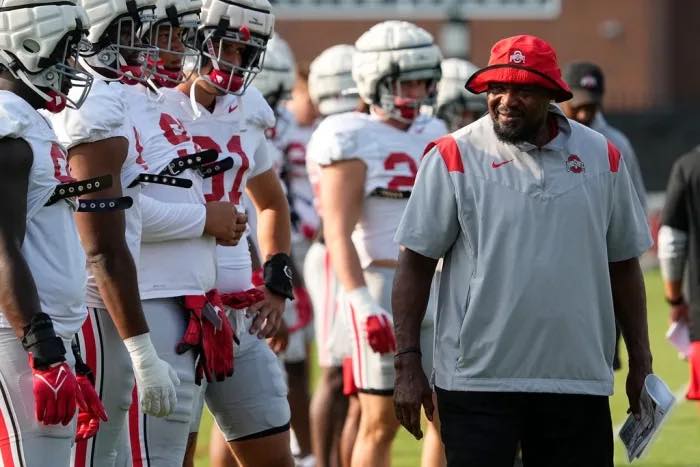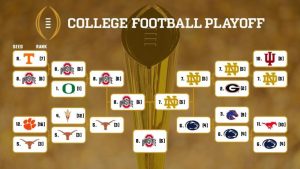
COLUMBUS, OH — Ohio State football has long been considered one of the premier brands in college athletics — a school rich in history, talent development, and NFL pipeline potential. But in today’s college football landscape, that isn’t always enough. In the new era of NIL (Name, Image, and Likeness), cash talks. And in one of the most high-profile recruiting swings and misses of the 2025 cycle, the Buckeyes’ latest five-star heartbreak may have come down to exactly that — money.
Sources close to the recruiting world are now reporting that a monster NIL deal, rumored to be well into seven figures, may have ultimately swayed one of Ohio State’s top targets away from Columbus and into the hands of a rival program — one that many previously considered a long shot in the recruitment.
The ripple effects of this development are already shaking up the recruiting narrative for the Buckeyes. Let’s break down what happened, why it matters, and how Ryan Day’s program may need to evolve to stay competitive in this high-dollar arms race.
The Miss: Ohio State Comes Up Short for Five-Star WR Jayden Ricks
Jayden Ricks — a 6’3”, 195-pound receiver out of IMG Academy in Florida — had been trending toward Ohio State for months. Ranked as the No. 2 wide receiver and a top-10 overall prospect in the 2025 class by multiple outlets, Ricks was widely expected to be the next superstar in Brian Hartline’s receiver factory.
Ohio State checked all the boxes. NFL lineage? Check. Development pipeline? Check. Compelling quarterback situation? Check. The Buckeyes had hosted Ricks multiple times, and the family was reportedly “blown away” by the facilities and Hartline’s proven résumé. At one point, insiders put Ohio State’s chances at 80%.
But recruiting is never over until the ink is dry.
On July 6, Ricks made his announcement — and it was not Ohio State. Instead, he committed to the University of Miami, a program many considered on the outside looking in for months. The Hurricanes, who have struggled with on-field consistency, swooped in late and flipped the narrative.
Within hours, speculation was rampant. Had something changed? Was there a family connection? Had Miami made a late push? The answer, it appears, was money.
The NIL Offer: Miami’s Reported $1.8M Deal Flips the Script
According to multiple recruiting insiders and a source close to Ricks’ high school program, Miami’s late offer included an NIL package reportedly worth $1.8 million over three years. The deal is said to involve endorsements, social media campaigns, and appearances with a South Florida-based tech company that has a licensing deal with Miami’s athletic department.
This NIL structure — which offers guaranteed payments in addition to performance bonuses — reportedly dwarfed what Ohio State was willing to provide.
While Ohio State has certainly been active in the NIL world (see: Quinn Ewers, Carnell Tate, and others), they have maintained a more “conservative” approach compared to schools like Miami, Texas A&M, and Oregon. In many cases, the Buckeyes have prioritized fit and development over cash-first commitments. But in the case of Ricks, that strategy may have cost them.
One recruiting analyst, speaking anonymously, said, “Ohio State did everything right on the football side. But Miami put together a business deal that was too good to pass up. At some point, the gap in dollars just becomes too wide.”
How This Impacts Ohio State’s 2025 Class
With the loss of Ricks, Ohio State now faces the possibility of missing out on a truly elite WR trio in 2025. They had hoped to pair Ricks with five-stars Winston Watkins Jr. and Zahir Mathis, creating yet another lethal receiver class. While they remain in strong position for the latter two, the absence of Ricks stings.
The Buckeyes currently hold the No. 6-ranked class in the 247Sports composite but are slipping behind SEC powerhouses like Georgia, Alabama, and Florida. The Ricks loss especially hurts when considering that OSU was seen as WRU — a title they’ve earned through the development of stars like Garrett Wilson, Chris Olave, Jaxon Smith-Njigba, and Marvin Harrison Jr.
This isn’t just a one-player loss — it’s symbolic. Losing an elite receiver to Miami, with NIL as the driving factor, sends a signal that Ohio State’s traditional advantages may no longer be enough.
Ryan Day’s Response: Adjust or Fall Behind?
To Day’s credit, he’s remained firm in his messaging around NIL: “We want to find young men who want to be Buckeyes — and we’re going to support them fully through NIL once they get here.” That strategy has worked well in the past, especially when combined with player development and NFL exposure.
But this might be the inflection point.
With more programs aggressively building NIL collectives and striking pre-commitment deals (often in gray-area legality), Ohio State’s “wait-and-develop” model might become outdated. It’s not that OSU lacks resources — it’s that other schools are willing to push the envelope sooner and harder.
Ohio State boosters and collectives like The Foundation have done impressive work in structuring post-enrollment deals, but there’s growing pressure on the administration and its partners to evolve further. Fans on message boards are already voicing concern:
“If we’re going to keep playing by the old rules, we’re going to keep losing to schools that don’t,” one popular post on Eleven Warriors read.
The Broader NIL Battle: CFB’s Wild West Era Continues
The Ricks recruitment highlights what many have described as college football’s Wild West — a landscape where bidding wars are replacing traditional recruiting pitches.
In the past two cycles, we’ve seen:
- A five-star quarterback reportedly receive $13 million from an SEC school (later reneged).
- A top DL flipping late after a rumored $1M endorsement offer.
- A West Coast QB choosing a mid-tier Pac-12 school after an NFT-based NIL deal.
Now, Jayden Ricks joins the growing list of recruits whose decisions are being shaped as much by their accountants as their coaches.
This isn’t necessarily a knock on the athletes — after all, most careers are short, and maximizing earning potential is smart business. But it’s changing the calculus for schools like Ohio State, who for decades relied on legacy, development, and culture.
What’s Next for Ohio State at WR?
All is not lost for Hartline and the Buckeyes.
While Ricks is gone, they are still in great position for Jalen Spears, a top-50 WR from Missouri, and Malik Benson, a four-star who’s drawing late buzz from the Midwest.
More importantly, Hartline’s past success still carries immense weight. Recruits know they’ll get elite coaching, NFL prep, and national exposure in Columbus. That matters — but increasingly, it must come alongside competitive NIL support.
Expect OSU to double down on locking up remaining WR targets before the early signing period, possibly with more structured NIL incentives that don’t cross NCAA lines but appeal more to recruits’ families and advisors.
The Pressure Is On: Buckeyes Must Adapt to Win
Ohio State has always been a powerhouse. But even the biggest brands must adapt to survive.
The loss of Jayden Ricks is a cautionary tale — a reminder that in 2025 and beyond, recruiting battles won’t just be won in living rooms or on visits. They’ll be won in boardrooms, on spreadsheets, and through creative NIL structures that align business with football.
Ryan Day and his staff remain among the best in the country at building relationships and developing talent. But the expectation in Columbus isn’t just top-10 finishes or Rose Bowl appearances — it’s national championships. And if securing future superstars means stepping further into the NIL arena, then so be it.
As one Big Ten coach recently told The Athletic, “If you’re not fully in the NIL game, you’re out of the game.”
Final Thoughts: NIL Reality Sets In
Jayden Ricks may very well have chosen Miami for personal reasons, or because he saw a clearer path to early playing time. But the widespread reports of a massive NIL deal raise unavoidable questions about the future of recruiting — and Ohio State’s place in it.
For Buckeye Nation, it’s a bitter pill. But perhaps it’s also the spark needed to ignite a more aggressive NIL posture — one that ensures elite talent doesn’t just visit Columbus, but stays there.
Because in today’s college football, culture still matters. But cash closes.





